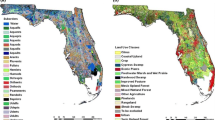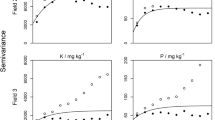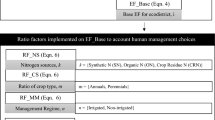Abstract
To reduce uncertainties in the highly variable estimates of NO emission from N fertilizer, we compiled and analyzed available reports of field measurements on fertilizer-induced NO emission. Three statistical distribution models, lognormal, gamma and Weibull, were used to fit the observation data. Results show that while all three models fit the observation data statistically, the lognormal model is not applicable to this data set. A mean fertilizer-induced NO emission ratio of 0.71% was derived from a Weibull distribution, which is the besting fitting model.

Similar content being viewed by others
References
Anderson R C Levine JS (1987) Simultaneous field measurements of biogenic emissions of nitric oxide and nitrous oxide. J Geophys Res 92(D1):965–976
Bouwman AF, Van Der Hoek KW, Olivier JGJ (1995) Uncertainties in the global source distribution of nitrous oxide. J Geophys Res 100:2785–2800
Bouwman AF, Boumans LJM, Batjes NH (2002a) Emissions of N2O and NO from fertilized fields: summary of available measurement data. Global Biogeochem Cycles 16(4):1058. DOI 101029/2001GB001811
Bouwman AF, Boumans LJM, Batjes NH (2002b) Modeling global annual N2O and NO emissions from fertilized fields. Global Biogeochem Cycles 16(4):1080. DOI 101029/2001GB001812
Davidson EA, Kingerlee W (1997) A global inventory of nitric oxide emissions from soils. Nutr Cycl Agroecosyst 48:37–50
European Environment Agency (1999) Joint EMEP/CORINAIR atmospheric emission inventory guidebook, 2nd edn. EEA, Copenhagen
Galbally IE (1989) Factors controlling NOx emissions from soils. In: Andreae MO, Schimel DS (eds) Exchange of trace gases between terrestrial ecosystems and the atmosphere. Wiley, Chichester, pp 23–37
Galbally IE, Freney JR, Muirhead WA, Simpson JR, Trevitt ACF, Chalk PM (1987) Emission of N oxides (NOx) from a flooded soil fertilized with urea: relation to other N loss processes. J Atmos Chem 5:343–365
Harrison RM, Yamulki S, Gouldling KWT, Webster CP (1995) Effect of fertilizer application on NO and N2O fluxes from agricultural fields. J Geophys Res 100(D12):25923–25931
Hou A, Tsuruta H (2003) Nitrous oxide and nitric oxide fluxes from an upland field in Japan: effect of urea type, placement, and crop residues. Nutr Cycl Agroecosyst 65(2):191–200
Hutchinson GL, Brams EA (1992) NO versus N2O emissions from an NH4 +-amended Bermuda grass pasture. J Geophys Res 97(D9):9889–9896
IPCC (1997) Greenhouse gas emissions from agricultural soils. In: Greenhouse gas inventory reference manual 1996 revision: IPCC guidelines for national greenhouse gas inventories. IPCC/OECD/IGES, Bracknell
IPCC (2001) Climate change—the scientific basis. In: Houghton JT, Ding Y, Griggs DJ, Noguer M, van der Linden PJ, Dai X, Maskell K, Johnson CA (eds) Contribution of working group I to the third assessment report of the intergovernmental panel on climate change. Cambridge University Press, Cambridge
Johansson C, Granat L (1984)Emission of nitric oxide from arable land. Tellus 36B:25–37
Kahn HD, Rubin RB (1989) Use of statistical methods in industrial water pollution control regulations in the United States. Environ Monit Assess 12:129–148
Koudo MJ, de Dioz JL, Ito S (2002) N2O and NO emission from an Andisol paddy soil as affected by soil moisture and N application method In: Abstracts of the annual meeting of the Japanese society of soil science and plant nutrition 48, April 2002. p 105
Ludwig JF, Meixner X, Vogel B, Forstner J (2001) Soil-air exchange of nitric oxide: an overview of processes environmental factors and modeling studies. Biogeochemistry 52:225–257
Matson PA, Billow C, Hall S, Zachariassen J (1996) Fertilization practices and soil variations control N oxide emissions from tropical sugar cane. J Geophys Res 101(D13):18533–18545
Röver M, Heinemeyer O, Kaiser E (1998) Microbial induced nitrous oxide emissions from an arable soil during winter. Soil Biol Biochem 30:1859–1865
SAIC (1996) Statistical analysis of hazardous air pollutant concentrations from hazardous waste combustors. Submitted to US Environmental Protection Agency, Contract No 68-W4-0030
Shepherd MF, Barzetti S, Hastie DR (1991) The production of atmospheric NOx and N2O from a fertilized agricultural soil. Atmos Environ 254:1961–1969
Shimizu K, Crow EL (1988) History genesis and properties. In: Crow EL, Shimizu K (eds) Lognormal distributions: theory and applications. Dekker, New York, pp 1–25
Skiba U, Fowler D, Smith KA (1997) Nitric oxide emissions from agricultural soils in temperate and tropical climates: sources controls and mitigation options. Nutr Cycl Agroecosyst 48:139–153
Slemr F, Seiler W (1984) Field measurements of NO and NO2 emissions from fertilized and unfertilized soils. J Atmos Chem 2:1-24
Slemr F, Seiler W (1991) Field study of environmental variables controlling the NO emissions from soil and the NO compensation point. J Geophys Res 96(D7):13017–13031
Thornton FC, Valente RJ (1996) Soil emissions of nitric oxide and nitrous oxide from no-till corn. Soil Sci Soc Am J 60:1127–1133
Thornton FC, Shurpal NJ, Bock BR, Reddy KC (1998) N2O and NO emissions from poultry litter and urea applications to Bermuda grass. Atmos Environ 32:1623–1630
Veldkamp E, Keller M (1997a) Fertilizer-induced nitric oxide emissions from agricultural soils. Nutr Cycl Agroecosyst 48:69–77
Veldkamp E, Keller M (1997b) N oxide emissions from a banana plantation in the humid tropics. J Geophys Res 120(D13):15889–15898
Veldkamp E, Keller M, Nunez M (1998) Effects of pasture management on N2O and NO emissions from soils in the humid tropics of Costa Rica. Global Biogeochem Cycles 12:71–79
Yan X, Hosen Y, Yagi K (2001) Nitrous oxide and nitric oxide emissions from maize field plots as affected by N fertilizer type and application method. Biol Fertil Soils 34:297–303
Yienger JJ, Levy H II (1995) Empirical model of global soil-biogenic NOx emissions. J Geophys Res 100(D6):11447–11464
Zhen X, Huang H, Wang Y, Wang M (2003) Seasonal characteristics of nitric oxide emission from typical Chinese rice-wheat rotation during the non-waterlogged period. Global Change Biol 9:219–227
Author information
Authors and Affiliations
Corresponding author
Rights and permissions
About this article
Cite this article
Yan, X., Shimizu, K., Akimoto, H. et al. Determining fertilizer-induced NO emission ratio from soils by a statistical distribution model. Biol Fertil Soils 39, 45–50 (2003). https://doi.org/10.1007/s00374-003-0665-7
Received:
Accepted:
Published:
Issue Date:
DOI: https://doi.org/10.1007/s00374-003-0665-7




